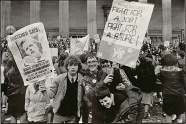Ancient Greece
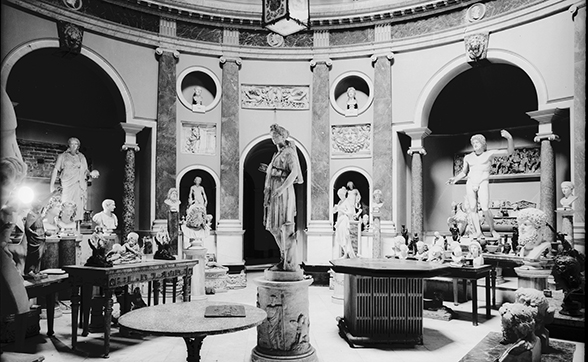
Image: The Pantheon Interior at Ince Blundell Hall, 1959 © National Museums Liverpool
In the early 1800s, architects such as John Foster and Harvey Lonsdale Elmes built Liverpool’s neoclassical cityscape as a second version of Ancient Greece. This allowed the rising elite of merchants who benefitted from colonial trade and the industrial revolution to fashion themselves, and their civic commitment, as a reenactment of the legendary cradle of democracy. In the Walker Art Gallery there is a watercolour by Samuel Austin, made in 1826, that continues this fiction. Depicting Carthage in ancient times, Austin uses Liverpool’s neoclassical buildings as a backdrop. This collapsing of space, time and stories mirrors the way in which the Ancient Greeks imagined and depicted their own myths on friezes and vessels. They didn’t tell stories with a beginning, middle and end, but depicted many stories in parallel, showing how multiple things happen at once, on a single plane.
Venues: The Oratory, Tate Liverpool, George's Dock Ventilation Tower Plaza
Chinatown
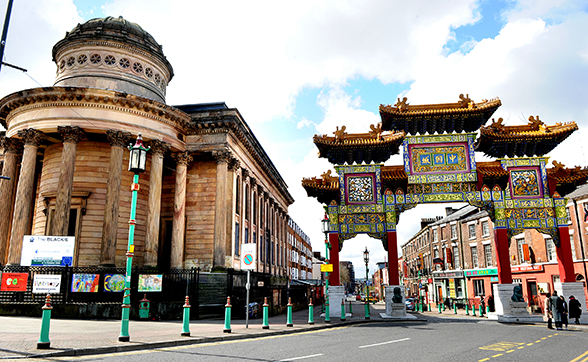
The Black-E and Chinese Arch. Photo: Shirlaine Forrest / Getty Images
Liverpool’s Chinatown has existed since the late 1890s and is the oldest in Europe. Its entrance is marked by a traditional arch imported from Shanghai. In the same way that the city’s merchant class linked itself to Ancient Greece through neoclassical architecture, this arch links Liverpool’s Chinese community to an image of home. Chinese immigration was, as with many migratory fluxes today, motivated by geographical labour demands and like the Greek fiction beneficial to Liverpool’s ruling class, Chinatown was beneficial to sailors and workers from a different continent. But as China itself changes, this architectural arch also shifts meaning. Many now see Chinatown as a nostalgic image of something that has become more dispersed, and that might even exist primarily in online networks, or through economic investment. Throughout Liverpool Biennial 2016, echoes of these different Chinatowns resound in spaces across the city.
Venues: Cains Brewery, Mr Chilli Restaurant, Master Chef Restaurant, Hondo Chinese Supermarket
Children's Episode

Marvin Gaye Chetwynd, Dogsy Ma Bone, 12 June 2016 at Cains Brewery, Liverpool. Courtesy the artist and Sadie Coles HQ, London. Photo: Mark McNulty
Children imagine the space between fiction and reality differently from adults, sometimes making no distinction between the two. They experiment with forms of social organisation constructed by adults, inventing new rules, and simultaneously creating new futures. For the Children’s Episode, artists have been invited to consider children as the primary audience: sometimes making work with them, sometimes for them.
Venues: Cains Brewery
Monuments from the Future
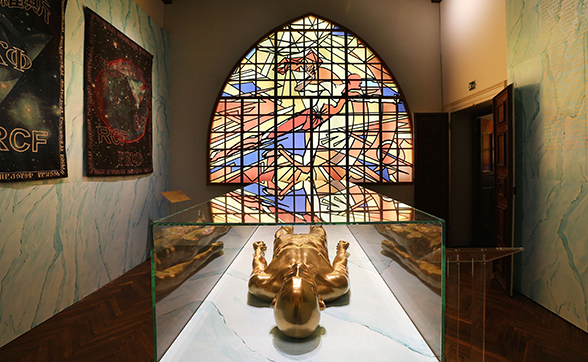
Arseny Zhilyaev, Cradle of Humankind, 2015. Courtesy of artist and V-A-C Foundation. Photo by Alex Maguire
For this episode, artists have been asked to assume the role of futurologists. They were invited to imagine what Liverpool might look like in 20, 30 or 40 years, and to design a monument for these scenarios. As a result, a series of public art commissions travel across time, appearing to be from the future but situated in the present.
Venues: Liverpool ONE, Derby Square, Exchange Flags, Toxteth Reservoir, 143 Granby Street, Rosebery Street, Rhiwlas Street, Epic Hotel
Flashback
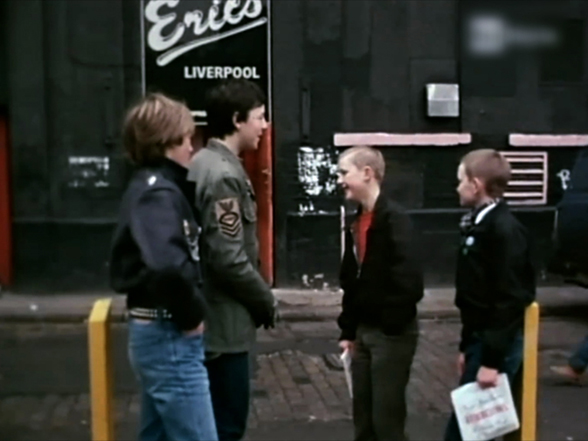
Mark Leckey, Dream English Kid, 1964 – 1999 AD ( lm stills), 2015. Courtesy the artist and Cabinet, London
A flashback is a way of experiencing history as it punctuates the present unexpectedly. Flashbacks can rupture established narratives and provide new understandings of the past. For instance, a building designed with the image of Ancient Greece in mind can help tell a story about another city thousands of years later, and the emergence of childhood memories in adulthood can help the understanding of new social realities. In this episode, which was prompted by a conversation with Krzysztof Wodiczko, artists interpret flashbacks through film and the exhibiting of artefacts that travel through time from a different reality to interrupt our own.
Venues: ABC Cinema, Cains Brewery, Blade Factory, FACT, Open Eye Gallery
Software

Ian Cheng, Emissary Forks at Perfection (detail), 2015. Courtesy the artist, Standard Oslo and Pilar Corrias
Software is usually considered as something functional, such as programmes, instructions or rules that direct the computer to perform specific operations, but it can also open a portal to other dimensions and imagined worlds. This episode points towards a broader understanding of software beyond technical application to ideas of scores and choreographies, through which one thing affects another without practical outcome. These scripts, running through the Biennial, generate additional and unexpected content and behaviour, create parallel understandings of art and life, and expand and produce new social forms and possible worlds. The episode opens up perspectives and aesthetic experiences for ‘users’, activating multiple portals that offer the ability to leap from one world to another, from everyday reality to the ‘nethersphere’ of computation and abstraction.
Venues: FACT, Bluecoat, LJMU Exhibition Research Lab, Derby Square, Online
